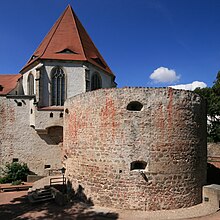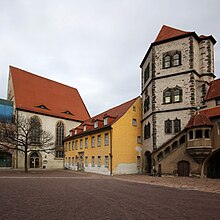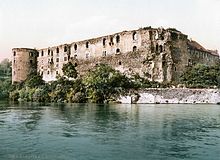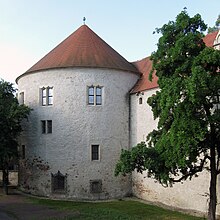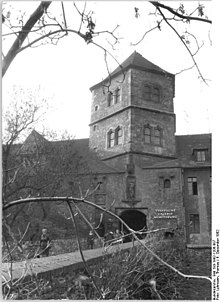Moritzburg (Hall)
| Moritzburg | |
|---|---|
 Moritzburg, Burgtor as the main entrance (2013) |
|
| Data | |
| place | Halle (Saale) , Saxony-Anhalt |
| builder | Conrad Pflüger (?), Andreas Günther, Carl Rehorst / Heinrich Quambusch, Fuensanta Nieto / Enrique Sobejano |
| Construction year | 1484 to 1503, 1884 to 1895, 1902 to 1904, 1911 to 1912, 2005 to 2008 |
| Floor space | 6120 m² |
| Coordinates | 51 ° 29 '10 " N , 11 ° 57' 48" E |
The Moritzburg is a fortified castle in Halle (Saale) . In 1484 the foundation stone for the later residence of the Magdeburg archbishops was laid. It was built in the late Gothic style and is today one of the most imposing buildings in the city of Halle.
During the Thirty Years' War , Moritzburg was largely damaged by fire in 1637, and in 1639 Saxon troops blew up the southwest bastion with a mine to force the Swedish occupation to surrender. After that, the castle remained largely in ruins and the residence of the Archbishop of Magdeburg was officially relocated to the neighboring New Residence , built in 1531 .
Since 1904, the Moritzburg has mainly housed an art museum with a national presence . From 2005 to December 2008, the north and west wings were expanded by the architects Enrique Sobejano and Fuensanta Nieto to expand the exhibition area. The expanded art museum has been accessible since December 13, 2008. Moritzburg is a property owned by the Saxony-Anhalt Cultural Foundation .
History of origin
The history of Moritzburg is closely linked to the history of the city of Halle. As early as the 13th century, the strong Pfänner aristocracy succeeded in freeing the city more and more from the influence of the sovereign, the Archbishop of Magdeburg , by buying freedoms and privileges . By 1263 Halle had practically achieved political autonomy .
In the 15th century, an opposition developed from the important craft guilds , striving for a seat and vote in the council, which was ruled by the old urban patriciate , the Pfännern. The opposition allied itself with the sovereign and in 1479 opened the city gates to the archbishop's troops. After a short resistance, the 14-year-old Archbishop Ernst von Wettin moved into the city. The downfall of urban freedom was sealed by the regimental order enacted by the Calber Landtag in 1479. The decision was: ... but delay in building a permanent castle at or in Halle in order to keep the city better in obedience, submission and calm .
Building history
Construction work began immediately. The first surveying work began in April 1479. However, the search for a suitable location turned out to be difficult due to the poor quality of the soil. He was then no longer found outside of the city , but with the inclusion of the city wall on the site of the former Jewish village in the north-west of the city. In a festive procession on May 25, 1484, Archbishop Ernst personally laid the foundation stone for his new residence, a permanent castle named after Moritzburg, the patron saint of the country, St. Mauritius . Ernst von Wettin and, expanding the plans, his successor Albrecht von Brandenburg developed a residency program for the first time in Germany with the Moritzburg.
The Moritzburg shows forms of the fading Gothic . But the almost regular floor plan , the uniform floor level and the representative effect of the horizontally emphasized façades prove that this is an early modern complex. The Moritzburg combines the terms fortress and castle . It combines the representative living needs and the military purpose.
Peter Hanschke, from East Prussia , was in charge of construction management at the beginning . Andreas Günther, general builder of the Archbishopric of Mainz and Magdeburg , built expanded ramparts and entrenchments and probably also the low, round bastions on the east side from 1533 . The design for the Magdalenenkapelle is attributed to Ulrich von Smedeberg.
Archbishop Ernst was able to move into the imposing building on May 25, 1503. He financed his ARX INSUPERABILIS (insurmountable fortress) primarily from the 1479 confiscated solgoods of the Halleschen Pfänner. The construction had, so Ernst announced at the state parliament in 1507 opposite the estates , cost over 150,000 guilders .
The lock
description
The floor plan forms an almost regular square with a side length of about 72 by 85 meters. Quarry stones were mainly used as building material for the Moritzburg . A 20 to 25 meter wide and 10 meter deep, formerly swampy trench surrounds the south, east and north sides. The west side was protected by a staggered system of kennels facing the hall . In front of the northern front is the Jägerschanze wall, which was raised in 1536–1538.
The inner courtyard, large enough for festivities, processions or jousting games , is raised to the level of the city streets.
West wing
The west wing is the main and front side of the castle. Its upper floors were converted into magnificent halls. The vaults of the upper basement are now used by the museum for exhibitions. The rooms for the crew were probably also located there. Above that, mostly in ruins today, lay two floors: the archbishop's state and state apartments. The prince's living quarters and the archbishop's library were located in the northern part . The only rudimentary staircase in the middle of the courtyard front is extremely remarkable. This is one of the first staircases in the German-speaking area that reaches into the structure and is not pre-formed on the outside.
North wing
The original main entrance was in the north wing of the castle. It is still recognizable today through a very beautiful coat of arms frieze. This access was abandoned and walled up in 1616. Above the basement there were two floors which served as the office for the officials and as an archive . On the occasion of the 200th anniversary of Halle University , fencing and gymnasiums were built in 1894 and used for physical education until 1990. In addition to the residential buildings, the palace chapel was probably the most important construction project at Moritzburg, even if construction began two years after moving in in 1505. In 1509 she was consecrated to Maria Magdalena.
East Side
In the middle of the east side is the entrance tower to the city. The tower was a residential tower with a chapel on the bottom floor. In order to prevent direct fire at the gate system, the entrance was built in a slight arch. The east wing originally consisted of a narrow two-story battlement . The lower storey was opened with arcades and equipped with loopholes . In 1777, the baroque building , named after its function as "hospital building", was built on the old foundation walls of the battlements for the Prussian garrison in the northern part . The southeastern bastion was expanded for the museum in 1913. The “Turm” student club is located in the north-eastern tower and was expanded as an FDJ student initiative in 1972 on the occasion of the Xth World Festival in Berlin .
South side
The south side is no longer original today. The farm buildings were located here, the kitchen also the apartment of the castle captain and the vital wells. The stables are also to be assumed here. The archbishop's mint was set up in the high vault below the courtyard level from 1582 to 1680 . From 1901 to 1904, the Talamt was rebuilt as a new museum building on the foundation walls of the timber-framed farm building. Two state rooms from the Talamt, originally located on Hallmarkt and demolished in 1881 due to road expansion, the courtroom and the festival room, were integrated into the new building. The Halloren Valley Office , built from 1594 to 1607, was the seat of the salt count and the valley court as well as the Halloren guild house.
history
The reign of the client, Ernst von Wettin, is characterized on the one hand by the victory over Halle in 1479, and on the other hand by his diverse support for the new royal seat.
Beginnings up to the Reformation
His successor was Albrecht V of Brandenburg, elected in 1513 . As Arch Chancellor of the Reich, Cardinal , Archbishop and Elector of Mainz, Archbishop of Magdeburg, and Administrator of Halberstadt , his favorite residence, Moritzburg, was the focus of European history. In 1517 he brought the Dominican Johann Tetzel to Moritzburg and initiated an upswing in the indulgence trade . He used it to finance his large collection of relics , the so-called Hallesche Heiltum . After an intensive collection, the Heiltum, which was set up in the castle chapel and then transferred to the cathedral , comprised 353 reliquaries with 21,484 individual relics, including 42 full-body relics. It was the most important collection of its kind in Germany. After the Reformation had been implemented in Halle, Albrecht gave up the city and withdrew to Mainz.
During the Schmalkaldic War , Moritzburg was occupied by imperial troops. On June 10, 1547, Emperor Charles V entered Halle after his victory in the Battle of Mühlberg . His general, Duke of Alba , occupied Moritzburg.
Thirty Years' War
During the Thirty Years War , the city of Halle and Moritzburg repeatedly attracted troops. In October 1625 Wallenstein occupied the city and the fortress. After the defeat of Breitenfeld , Tilly initially withdrew to Moritzburg, pursued by the Swedes. In September 1631 the Swedish King Gustav Adolf appeared in front of Halle and was able to occupy the city and Moritzburg for a long time without a fight. With the Peace of Prague (1635) the emperor recognized the Duke August von Sachsen-Weißenfels as the new archbishop. During another siege by the Swedes on January 6, 1637 a fire broke out in the castle. The entire upper floors of the west and north sides as well as the chapel were destroyed. The crew then capitulated.
On March 19, 1639, Saxon troops blew up the southwest bastion with a mine attached to the foundation in order to force the now Swedish occupation to give up, which happened three days later. August, the son of the Saxon elector, was appointed archbishop. He got his father Johann Georg von Sachsen to get the Saxon troops to vacate the fortress in order to take away its strategic attraction. A neutrality treaty between August and the Swedes kept Halle from continuing the war. The Moritzburg was not rebuilt, only the chapel was partially reconstructed later so that it could be used again for church services .
The Moritzburg comes to Brandenburg / Prussia

With the death of August in 1680, Halle fell under the provisions of the Peace of Westphalia to Brandenburg . In 1686 the Huguenots who settled in Halle received the chapel in the gate tower of the Moritzburg for their services. On October 26, 1690, the community took possession of the Magdalen Chapel.
In 1717 the Prussian Anhalt Regiment with around 3,500 soldiers got the Moritzburg. A parade ground was created in front of the facility , on which the general, Prince Leopold of Anhalt-Dessau , the “old man from Dessau”, drilled the soldiers.
The Moritzburg served as a military hospital in both the Seven Years' War and the Wars of Liberation . The vaults were later leased to a brewery and the chapel, used by the French community until 1808, served as a warehouse. The Prussian state bought the ruins back from the tenants for 24,800 thalers between 1847 and 1852.
An interesting project for the history of monument preservation was the planned new construction of the facility for the university in the city of Halle by Karl Friedrich Schinkel . However, the plan failed because of the costs.
By 1900 the structural condition of the facility had deteriorated threateningly. In 1897 the Prussian state ceded the east, south and west wings to the city for the Municipal Museum for Art and Applied Arts, founded in 1885. Thanks to donations from the citizens of Halle, the Talamt, the southern battlements, the gate tower and the southern bastion were expanded and rebuilt for a museum between 1901 and 1913. Since 1904, parts of the Moritzburg were the second exhibition site of the Städtisches Kunstmuseum am Großer Berlin. All collections and exhibitions have been in the Moritzburg since 1921.
Second World War to this day
In World War II the deep vaults served the facility as an air raid shelter for the population and the district leadership of the Nazi Party . Valuable portals and architectural parts were also stored in the basement.
From 1951 to 1954 the upper vaults of the west wing could be extended. In the south and east wings, the art museum, now known as the Moritzburg State Gallery, had exhibition rooms. In the second basement of the west wing, a small chamber theater and restaurant were built between 1964 and 1967. From 1972 to 1973 a student club was established in the north-east bastion - the premises are currently still used as a generally accessible venue by the company Turm event - and the cabaret Die Kiebitzensteiner played for a long time in the round hall of the south-east bastion .
Since the 1990s, the Moritzburg has been used exclusively by the Moritzburg Art Museum in Halle (Saale) and reconstruction work is ongoing there. In October 2003, an architecture competition for the new or extension of the exhibition rooms in the north and west wings of Moritzburg was announced (see web links) , which was won by the Spanish architect couple Fuensanta Nieto and Enrique Sobejano. In the course of the subsequent extensive renovation work, the former west wing ruins and the north wing were given a new, futuristic-looking, folded-out roof, which gave the museum new exhibition space. The renovation was completed in 2008. On May 8, 2010 the expressive exhibition wing by Nieto Sobejano Arquitectos (Enrique Sobejano and Fuensanta Nieto) received the BDA architecture prize “Nike” in the category “best atmospheric effect”.
The Maria Magdalenen Chapel
The Maria Magdalenen Chapel is the artistic gem of Moritzburg. Despite the small floor plan of 14 × 23 m and the height of 15 m, the interior appears spacious with its design in the tradition of the Upper Saxon late Gothic sacred building . Designed as a wall pillar church , free-standing round pillars that accommodate the vaults rise above the gallery walkway resting on arched arcades. The hall with a three-sided east end and a gallery is located in the eastern part of the north wing.
On the north wall is the memorial plaque for the consecration in 1514 with the coat of arms of Cardinal Albrecht von Brandenburg flanked by Saint Mauritius and Saint Mary Magdalene .
A coat of arms specially designed for the chapel on the west wall above the gallery , next to the console stone with the access to the bishop's chair , dates the completion for Archbishop Ernst II of Saxony to 1509, although the papal confirmation did not arrive until years later. At the beginning of August 1513, Archbishop Ernst's heart was laid to rest in the Maria Magdalenen Chapel. The chapel dedicated to the healing community was generously furnished. Originally there were 20 altars distributed in the chapel wreath. 29 people were scheduled for the service.
In 1637 the Maria Magdalenen Chapel lost its vault, which - apart from a makeshift repair after the Thirty Years War - was not reconstructed until two centuries later, from 1894 to 1899. On October 26, 1690, the Huguenot congregation celebrated their first service here, and in 1705 the first preacher of the French Reformed congregation in Halle, Jean Vimielle, was buried in the chapel.
The dilapidated Magdalenenkapelle had been a hay and straw store since 1805 after the battle of Jena and Auerstedt in 1806 even a hospital. During a tour of Moritzburg in 1817, the Prussian Crown Prince Wilhelm was so impressed that he became a proven sponsor of the reconstruction of the castle. From October 23, 1822, the Moritzburg with the Maria Magdalenen Chapel was also designated as a monument by the Prussian building authorities .
Drafts for the restoration and refurbishment of the chapel existed from 1888. On the occasion of the 200th anniversary of the university (founded in 1694), it was converted into a university church between 1898 and 1899 . The historicizing painting, the neo-Gothic furnishings with the pulpit altar and the organ from the Zörbig workshop of Wilhelm Rühlmann also date from the restoration period. In 1963 the organ was cleaned and its sound structure changed. In 1990 the Evangelical Lutheran Congregation decided to build a new organ in the existing, listed housing. It was consecrated that same year.
The three choir windows are designed in the style of late historicism . Following on from the picture window tradition of the 14th century, a rich architectural framework fills the large window openings. The church coat of arms and the consecration plaque were evidence of the early days of the church, so the new vault offered space for 3 × 5 new coats of arms. The keystones in the Ostjoch , Mitteljoch and Westjoch are provided with the coat of arms of the Hohenzollern family, the University of Halle with its faculties and the coat of arms of the Province of Saxony .
The chapel is the place of worship and home to two church communities: the Evangelical-Union University Church Congregation and the Evangelical-Lutheran Church Congregation Halle / Saale zu St. Magdalena, which belongs to the church district of Saxony-Thuringia of the Independent Evangelical Lutheran Church .
Art Museum Moritzburg Halle (Saale) - Art Museum of the State of Saxony-Anhalt
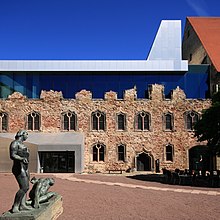
Today's Art Museum Moritzburg Halle (Saale) was founded as the Municipal Museum for Art and Applied Arts in 1885 in the old calibration and weighing office on the Great Berlin in the south of the historic old town of Halle. The small founding collection - at the opening it comprised 10 paintings - has already been expanded by the museum's first honorary curator, Franz Otto, including the purchase of Hellweg's South Sea Collection in 1899 and, above all, donations from various art collectors, such as Adolph Thiem .
In 1904 the second location of the museum was opened in Moritzburg. For this purpose, a historicizing replica of the former Thalamt des Salzgrafen was built in the south wing of the building ensemble, which had been destroyed since the 17th century. The two historic rooms (the banqueting room and the courtroom) were originally recovered and integrated into the upper floor of the new building. In 1904, the Talamt was opened as a museum in Moritzburg. Until 1920, the rooms at the Great Berlin functioned as a picture gallery and the rooms in the Talamt in the Moritzburg as a presentation of the handicraft collection. The first professional director from 1908 until the First World War was Max Sauerlandt . He significantly expanded the two collection strands of fine and applied arts and placed the focus on contemporary modern art. In 1920 the museum had to vacate the premises on Great Berlin. All collections have been concentrated and exhibited in Moritzburg since 1921. In 1924, under the provisional direction of the rector of Burg Giebichenstein Paul Thiersch , the museum acquired 24 expressionist works from the Rosy Fischer collection. In 1929, under the direction of director Alois Schardt , the museum was one of the first to have electrical lighting. Under Schardt, the collection of paintings a. a. through a representative bundle of works by the Russian constructivist El Lissitzky .
In 1931 Charles Crodel completed the mural Race of the Atalante and Hippomenes (completed on November 21, 1931) in what was then the gymnastics room of the university , now the Crodel Hall .
For a contract from the city, Schardt brought Bauhaus master Lyonel Feininger to Halle in 1929 , who set up his studio in the gate tower of Moritzburg. The famous series of his Halle pictures were closed for the museum in 1931. Through other acquisitions, including from Franz Marc and Oskar Kokoschka , the museum in Moritzburg has built a legendary reputation.
With the takeover of power by the National Socialists and the defamation of modern art as “ degenerate art ”, this collection was in danger. The collection of classic modern art was confiscated for the propaganda show of the same name in Munich and later sale abroad . With that, the museum lost its outstanding works.
From 1938 to 1945 the art journalist and NSDAP functionary Robert Scholz was director of the museum.
As early as July 1945, the Halle magistrate decided to buy back the former holdings. Major acquisitions were made up to 1949 under the important post-war director of the museum, Gerhard Händler . The museum was officially reopened on October 7, 1948. When the State Gallery of Saxony-Anhalt was dissolved in 1952, the museum was renamed Staatliche Galerie Moritzburg . In 1996 the previously municipal museum was transferred to the sponsorship of the state of Saxony-Anhalt . In 2003 it was transferred to a foundation , the Moritzburg Foundation - Art Museum of the State of Saxony-Anhalt, to which the Lyonel Feininger Gallery in Quedlinburg was added in 2006 . Since January 1, 2014 the now legally dependent Moritzburg Foundation has been managed in trust by the Saxony-Anhalt Cultural Foundation and the museum operates under the name Kunstmuseum Moritzburg Halle (Saale).
Collection of paintings
The painting collection includes around 1,800 works. In addition to the focus on expressionism, socio-critical art and the art of the GDR, painting from the 19th century is also represented. The museum also has works of late Gothic art and paintings from the 17th and 18th centuries.
On the birthday of the Halle painter Albert Ebert on April 26, 2009, the Moritzburg Foundation donated an art chamber to the city of Halle for the painter's pictures. The Albert Elbert Board of Trustees presented two paintings that were acquired from private ownership for the new cabinet.
Graphic cabinet
The focus is on German graphics of the 20th century with expressionist and constructivist art . Works by artists from the GDR are comprehensively documented. A separate group of sculptors ' drawings and leaflets from the 15th to 19th centuries are another special area of collection. The Grafisches Kabinett comprises over 37,000 works.
Plastic collection
This collection contains around 700 works from the Middle Ages to the present day. The focus is on figurative German sculpture of the 20th century. Works by Lehmbruck , Kolbe and Kogan were acquired early on. Work groups and significant individual works by Ernst Barlach , Gaul, Max Klinger , Gerhard Marcks , Marc and Wolfgang Mattheuer show currents and tendencies in German sculpture. In addition, the museum has a good inventory of medieval carved sculptures from Central Germany.
Handicraft collection
As early as 1914, a small qualitative collection of Venetian, Dutch and German glasses, Rhenish and Central German stoneware, French, Dutch and German faience as well as Thuringian and Meissen porcelain could be presented. One focus of the collection is Halle's works. The core of the collection of goldsmiths are works by Hallesch goldsmiths from around 1700.
State Coin Cabinet Saxony-Anhalt
The State Coin Cabinet of Saxony-Anhalt has been an independent department of the gallery since 1950. A stock of around 80,000 coins , medals and banknotes is kept. The Mansfeld coins and medals, the minting of the Counts of Stolberg and the Anhalt coins, medals, orders, decorations and loges have a special rank . More than 4,000 pieces document the history of coins and money in Brandenburg-Prussia.
Collection photography
The photography collection was founded in 1986 by donating the estate of photographer Hans Finsler . Collection area is artistic photography of classical modernism and the present.
The art museum Moritzburg Halle (Saale) shows changing exhibitions primarily on contemporary fine arts and contemporary handicrafts as well as classical modernism.
management
Katja Schneider -Stief, who has a doctorate in art history, was the director and board member of the Moritzburg Foundation until her resignation on January 1, 2013 (announced at the Board of Trustees meeting on December 19, 2012). The deputy director and head of the collections at the Moritzburg Foundation, Michael Freitag, then took on artistic responsibility on an interim basis. Thomas Bauer-Friedrich , former curator at the Chemnitz Museum Gunzenhauser , has been director of the art museum of the state of Saxony-Anhalt since March 1, 2014 .
General
The Moritzburg was the last of the castles built in large numbers along the Saale . The city of Halle has the oldest and youngest of all Saale castles, Giebichenstein Castle and Moritzburg.
The Moritzburg Halle (Saale) Foundation - Art Museum of the State of Saxony-Anhalt was included in the Blue Book published in 2001. The Blue Book is a list of nationally significant cultural institutions in East Germany and includes a varying number of so-called cultural lighthouses that are associated with the Conference of National Cultural Institutions .
Special exhibitions
- 2016/2017: Woven dreams - the tapestry in Central Germany. Reflections on Jean Lurçat . Catalog.
- 2018/2019: Gustav Klimt, on the occasion of the 100th year of the artist's death
- 2019: The silence in the noise of time, masterpieces from the Ziegler Collection, Mülheim an der Ruhr Art Museum
literature
- Andreas Hüneke : The Moritzburg in Halle. (Architectural monuments 43). EA Seemann, Leipzig 1978, DNB 790202298 .
- Ulf Dräger: Moritzburg Halle / Saale . Schnell & Steiner, Regensburg 1995, DNB 944254179 .
- Andreas Stahl: The Moritzburg in Halle . Schnell & Steiner, Regensburg 2002, ISBN 3-7954-1480-6 .
- Michael Rockmann: A “very impressive building” - the Moritzburg in the history of Halle 1503–2003 . mdv, Halle 2004, ISBN 3-89812-248-4 .
- Karl Heldmann : The St. Maria Magdalenen Chapel on the Moritzburg in Halle. Four hundred years of church and cultural history in Halle. Hall / S. 1923
- Heinrich Nickel (Ed.): The Maria Magdalenen Chapel of Moritzburg in Halle. Stekovics, Halle 1999, ISBN 3-932863-35-6 .
- Author collective: Staatliche Galerie Moritzburg Halle . Moritzburg Foundation, Halle 1994, ISBN 3-86105-056-0 .
- Kurt Fricke: 25 years of the “Turm” student club in Halle / Saale 1973–1998. Hall 1998.
- Kurt Fricke: Student life in Halle in the 1970s / 80s - the tower student club. In: History of the city of Halle. Vol. 2: Werner Freitag, Katrin Minner (Ed.): Halle in the 19th and 20th centuries. Halle 2006, ISBN 3-89812-383-9 , pp. 457-468.
The Moritzburg Foundation has its own publishing house and has an extensive publishing program on various artistic and art-historical topics. In addition, catalogs of own exhibitions and work shows are published regularly.
Web links
- Moritzburg Art Museum Halle (Saale)
- Hello Modern Art Museum Moritzburg Halle (Saale)
- Report from Deutsche Welle TV about the Moritzburg
- The Maria Magdalenen Chapel on the Moritzburg in words and pictures
- Expansion of the Moritzburg
- Entry of the library of the Staatliche Galerie Moritzburg in the online edition of the manual of historical book collections
- Object collection of the Moritzburg Art Museum on museum-digital.de
Individual evidence
- ↑ Willy Schilling: Saxony-Anhalt 1933-1945: the historical travel guide. Ch. Links Verlag, 2013, p. 85 books.google.de
- ↑ Quoted from the museum's web link
- ↑ Fig. In: Andreas Hüneke : The Moritzburg in Halle. Halle 1978, p. 27.
- ^ Charles Crodel (1894–1973): Catalog raisonné of building-related works ( Memento of March 5, 2006 in the Internet Archive )
- ^ Charles (Carl Fritz David) Crodel. on: mural.ch
- ↑ The Moritzburg Board of Trustees met on December 19, 2012: Moritzburg Director Katja Schneider announced her resignation at the turn of the year. from: stiftung-moritzburg.de accessed on January 30, 2013.
- ↑ Focus online Regional (Beta) | Halle-Saale Museen from February 20, 2014: The new director of Moritzburg sees great potential in depots , accessed on February 20, 2014




